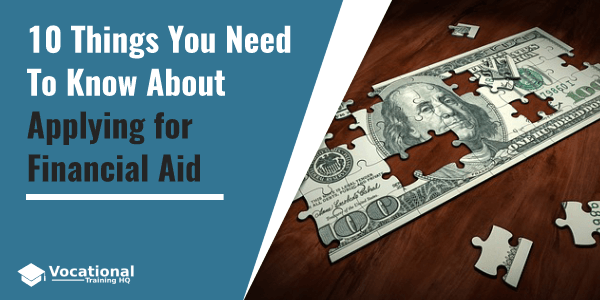When it comes to college education and starting a career, every student faces the issue of paying for the training.
The question is where to get money to pay for education and whether it is possible to reduce expenses.
Article Table of Contents
- 1 How to Overcome a Sticker Shock?
- 2 Determine Your Financial Situation
- 3 Learn the Difference Between Need-Based Aid and Merit-Based
- 4 Learn About Merits that Can Work for You
- 5 Learn About Loans, Grants, and Work-Study Options
- 6 Complete the FAFSA
- 7 Look for Private Loan Options
- 8 Don’t Forget About Deadlines
- 9 Colleges Want To Help
- 10 Don’t Be Afraid to Appeal an Offer
- 11 Don’t Base Your Choice on Finances Alone
How to Overcome a Sticker Shock?
During the last 20 years, higher education has become much more expensive.
Lots of students and families have a real sticker shock when they learn about college tuition.
Nevertheless, it doesn’t mean that it’s impossible to deal with this problem.
According to the College Board, you need to pay about $10,230 per year for your full-time in-state training at a 4-year public college.
When it comes to out-of-state colleges, you need to pay about $26,290 annually which is significantly higher.
At the same time, the most expensive option is a private university that costs about $35 830 per year.
Considering the high prices and their constant increase, financial aid programs can be a perfect option for those who want to get a college education but don’t have enough money.
Determine Your Financial Situation
First of all, you need to have an honest look at your financial situation to understand whether you can pay tuition or you need some financial aid.
Can your parents help you with tuition fees and will it be enough?
It is important to have a clear view of the situation.
It will let you set realistic expectations and understand what financial aid you need to achieve your goal.
Learn the Difference Between Need-Based Aid and Merit-Based
There are two main types of financial assistance – need-based and merit-based.
Before applying for any form of financial aid, you need to understand the difference between these two types.
Merit-Based Aid
Only students who have a certain level of academic performance and some achievements can apply for this type of financial aid.
Usually, it is provided in the form of a scholarship that is awarded through a private institution or school.
Need-Based Aid
This type of financial aid is available for any student who or whose family cannot pay tuition.
If you can apply for need-based financial aid, you have an opportunity to get a private and/or federal grant or student loan.
Learn About Merits that Can Work for You
As we’ve already mentioned, merit-based financial aid can be obtained only through your performance at school and extracurricular activities.
To get info about the available offers, first of all, you need to address our high school guidance counselor.
It is a perfect opportunity to learn about local, state, and organizational programs that fit your talents and skills.
If you have a gap because of any reason or you are a working adult who decided to return to school, you can address the university’s financial aid advisor and ask for help.
Also, most colleges and universities tend to provide info about available merit scholarships on their official websites.
Moreover, you can use Scholarship.com and Fastweb.com services to learn about all the available options to reduce your tuition.
Learn About Loans, Grants, and Work-Study Options
When it comes to need-based financial aid there are three main options you can apply for.
Before deciding on which form you should apply, you need to learn about each of them and find the one that suits your needs.
Loans
Federal student loans are a great option for those students who need to make up the difference they need to pay after getting some merit-based aid.
After completing your education, you need to pay back the loan.
Grants
Grants are a form of need-based aid that shouldn’t be repaid after completing your training.
If you are a student in need, you can apply for several Federal and state grants.
To learn about the available options, you need to fill out the FASFA first of all.
Work-Study
Applying for the Federal work-study program, you can get some part-time employment options so you can earn money for your education while learning.
It is a great opportunity not only to earn some money to pay tuition but also to earn some great experience in the field of your interest.
Complete the FAFSA
After learning about all the available financial aid options, you need to fill out the Free Application for Federal Student Aid (FAFSA).
If you want to apply for need-based aid, you need to prove that you are eligible for it and the FASFA aims to prove it.
Just keep in mind that some schools and colleges require some additional form so you can apply for financial aid.
You need to get in touch with your college representative and learn about any specific requirements your college has when it comes to financial aid.
To complete the FASFA form, just use the official website which is pretty friendly.
If you want to make the process faster and easier, just prepare some items beforehand:
- Your and your parent’s social security numbers;
- Your driver’s license number;
- Federal tax information or returns both yours and your family members (parents/spouse);
- Records of untaxed income;
- Bank account, investment, and real estate asset information.
* PRO TIP: Find a good bank account that fits your needs, don’t overpay, and check out some of the best bank promotions to find a bank account.
If you want to understand what financial you are eligible to get before applying for college, you can use FAFSA4caster.
It is a great opportunity to reveal the amount of financial aid you can get before choosing a college.
There is a FASFA app as well, so you can fill out your form any time you want.
Look for Private Loan Options
Of course, applying merit-based and need-based Federal programs is the first thing you should do.
However, if it’s not enough to cover your tuition so you can complete your training, you should consider applying for a private student loan.
Just keep in mind that this option has its own price.
In fact, you can consider it as the last thing you should apply for if you need financial aid as the rates are incredibly high.
Especially, you need to be aware of private loan issues as their rates are especially high.
Moreover, when it comes to Federal loans, you don’t need to pay them back while you are still at school but it can be true for private ones.
Also, in most cases, you cannot apply for forbearance, consolidation, or loan forgiveness when it comes to private loans.
Don’t Forget About Deadlines
You need to keep in mind that most financial aid programs have early deadlines and you need to complete your application before it comes.
In other words, you need to learn about the deadlines of programs you are eligible for as soon as you can if you don’t want to miss it.
If you need to provide FASFA, you can fill out the form starting from January 1st of the year you will be attending college and the submission starts on October 1st every year.
Don’t waste your time and complete and submit it as soon as possible as it influences the amount of financial aid you may get.
Colleges Want To Help
There are lots of students who have problems with paying their tuition because of financial difficulties.
As a result, financial aid officials do a great job of helping students deal with the issue.
Just keep in mind that the earlier you start working on this problem the higher your chances to get some great piece of financial aid.
Learn about the financial aid programs offered at your prospective colleges.
To get more info about available options, you need to contact your college representative or visit its website.
Also, there are a bunch of colleges that provide payment plans to help their students pay tuition without going into debt.
If you want to learn about such colleges, you can look for the list online.
Don’t Be Afraid to Appeal an Offer
Even if you did everything possible, it still may happen that you won’t get enough financial aid.
Nevertheless, there is no need to panic.
Financial aid officials are quite understandable so never hesitate to address your college directly to ask about some financial assistance.
In other words, colleges can reconsider and adjust their financial aid formula on a case-by-case basis if you know that you need some more help with your tuition.
Don’t Base Your Choice on Finances Alone
When it comes to your college of choice, there are lots of points that influence your decision.
It should offer the program you are interested in and suit both your financial situation and lifestyle.
If you want to be able to work on a full-time basis and get your training, consider applying for online training programs.
There are lots of great colleges that offer some high-quality online training programs.
As you understand it is really important, that the college you are interested in suits all your needs, goals, and preferences.
Just remember that college can be one of the best investments in your life.
Despite being a big step to your future, it always requires a great amount of investment.
However, it doesn’t mean you should refuse to get your higher education as there is a variety of financial aid types you can apply for.
In other words, you can achieve your goal if you do some proper research and take your time to find suitable options.
Read more: How Much Does College Cost? Here’s A Simple English Answer!











